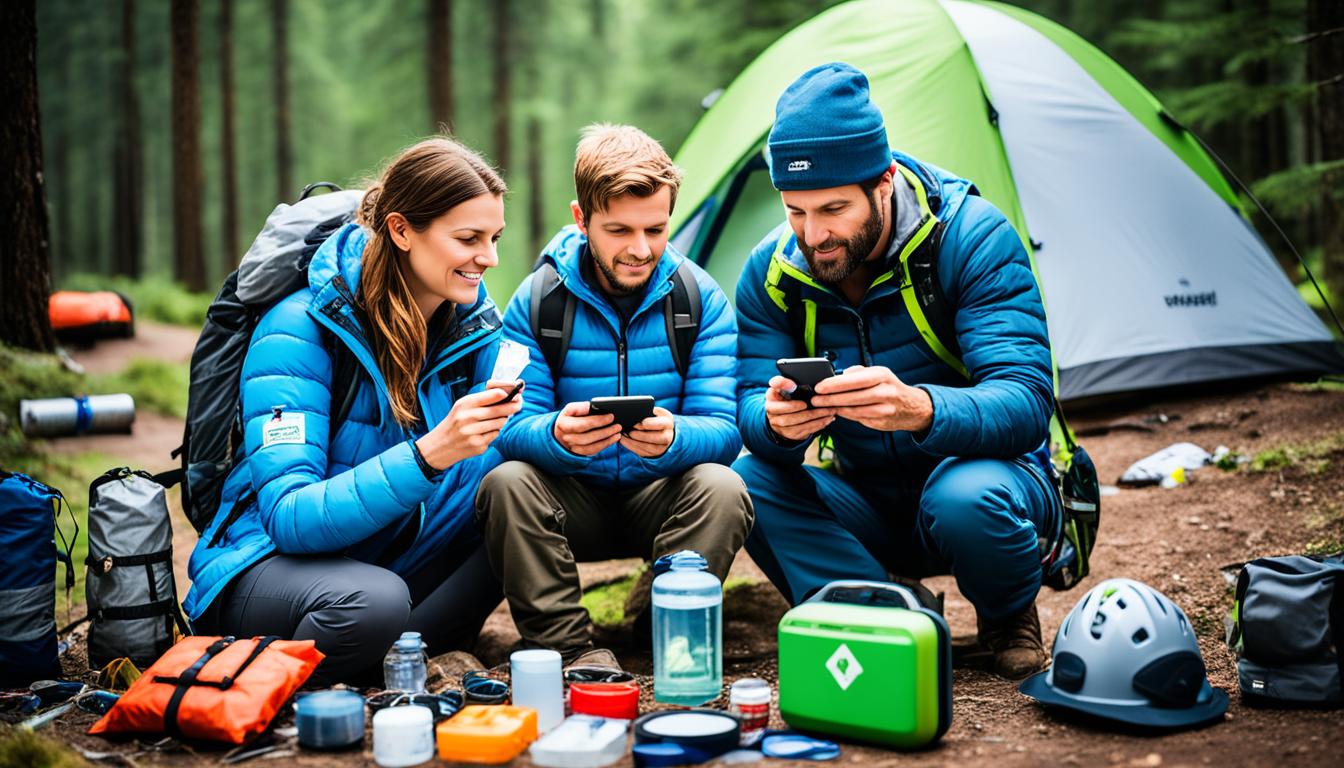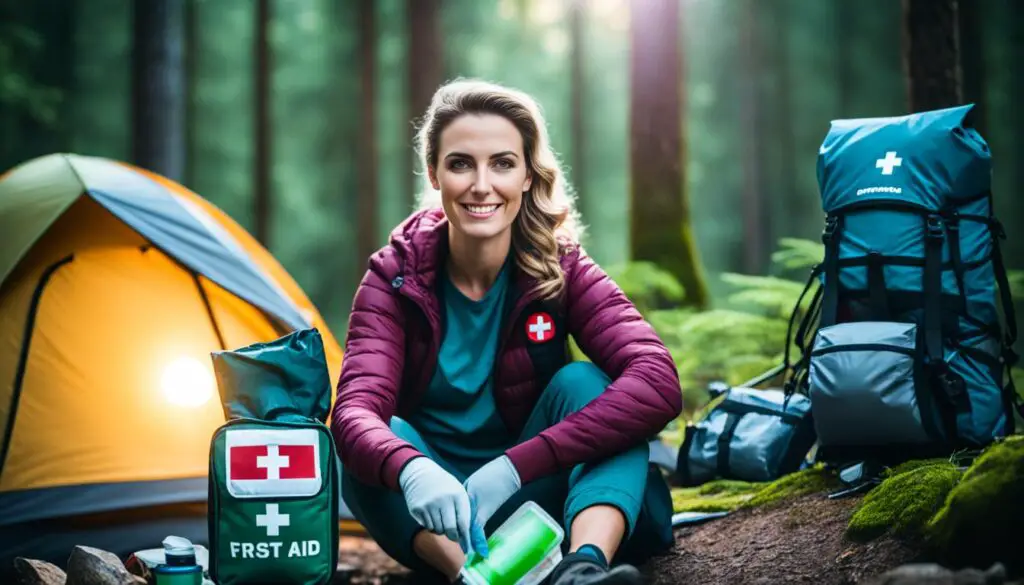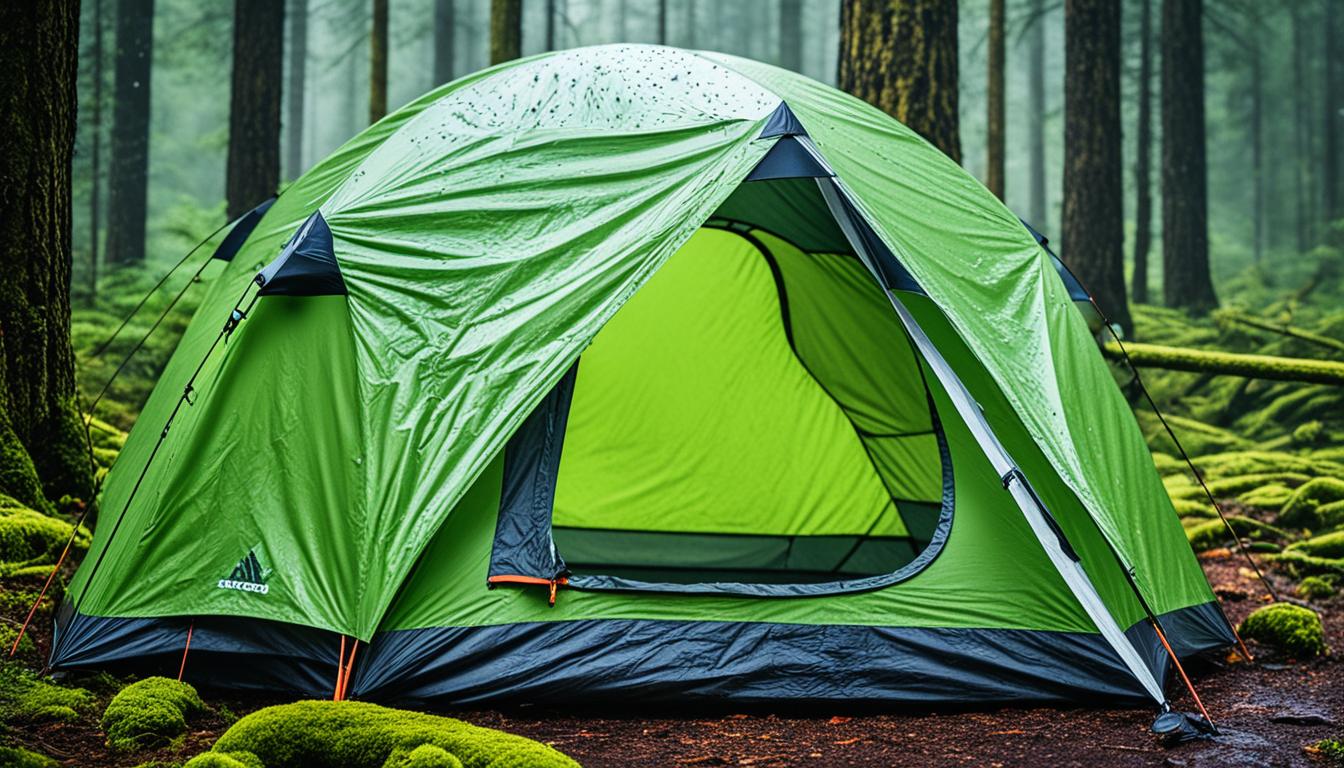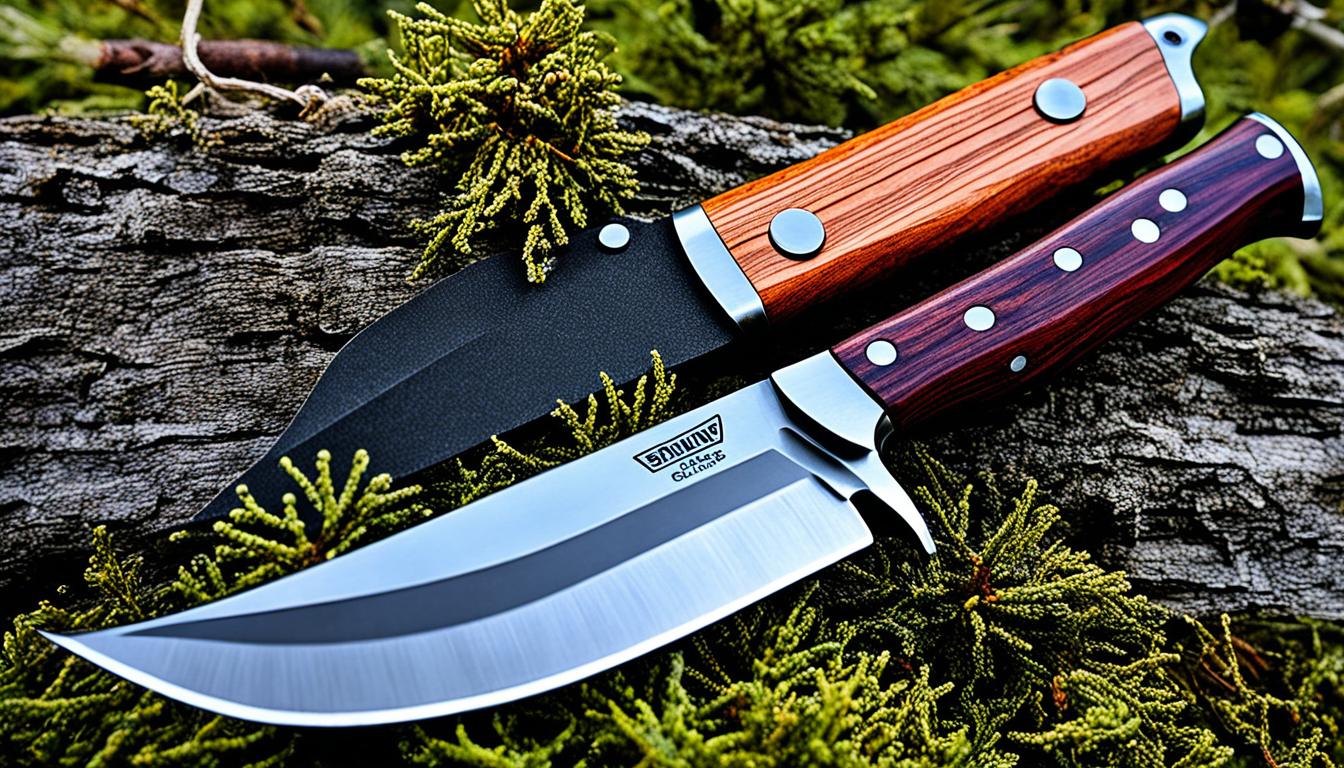
Camping helps us get close to nature and have fun outside. But, keeping camping safety in mind is key. It ensures our trip is safe and enjoyable. Let’s look into why camping safety is vital and how to prepare for our outdoor adventure.
Heading out to explore nature is exciting. Yet, it’s important to prepare for wilderness hazards. By focusing on camping safety, we lessen risks. This lets us fully enjoy the wilderness’s beauty, knowing we’re safe.
Great emergency planning is essential for a fun camping trip. Soon, we’ll cover important camping safety basics. This info will help you face outdoor challenges with confidence and stay safe.
Introduction to Camping Safety
Starting a camping adventure is exciting and fun. But, it’s important to put camping safety basics first. This helps ensure you have a safe and great time. Knowing about the outdoor preparedness and possible wilderness hazards is key. It helps in managing camping risk management and keeping emergency readiness.
Importance of Being Prepared
Preparation is essential in camping safety basics. Before heading out, research your campsite and get to know the area. Don’t forget to pack important camping safety gear. This includes a first-aid kit, maps, and emergency supplies.
Common Camping Hazards
The wild has its dangers, like bad weather, wild animals, and more. These are the wilderness hazards you should know about. By learning and being prepared, you can reduce risks. This makes your camping trip safe and fun.
Don’t overlook outdoor preparedness and emergency readiness in camping safety basics. Staying informed and ready is vital. It lets you enjoy nature’s beauty while staying safe.
Essential Camping Safety Gear
Choosing the right camping safety gear is key to staying safe outdoors. It helps you explore the wild while keeping yourself and others protected. This guide will show you what essential items to pack for safe and thrilling adventures.
Navigation and Survival Essentials
When going into the wild, good navigation tools are a must. A quality compass, map, and GPS will keep you on track. Add a flashlight, whistle, and a multi-tool for extra safety.
Protection and Security
Protecting your camp area is important. Bring a strong tent, tarp, and a shelter. Use a bear-resistant food container to keep animals away. Ropes and clips will secure your campsite better.
First Aid and Emergency Preparedness
Always have a great first aid kit. It should have bandages, wipes, and medicines. Pack a whistle, fire starter, and a mirror for worse situations. They can help you get spotted and rescued.
The right camping gear lets you enjoy nature without worries. Being prepared is how you have a great and safe time.
| Camping Safety Gear | Description |
|---|---|
| Compass | A reliable compass to help you navigate the wilderness |
| Map | A detailed map of the camping area to aid in navigation |
| GPS Device | A GPS device to provide accurate location tracking and route guidance |
| Flashlight | A high-quality flashlight or headlamp for illumination in low-light conditions |
| Whistle | A whistle that can be used to signal for help in an emergency |
| Multi-tool | A versatile multi-tool with various functions, such as pliers, knife, and screwdrivers |
| Tent | A durable, weatherproof tent to provide shelter and protection |
| Bear-resistant Container | A specialized container designed to keep wildlife away from your food and supplies |
| Rope and Carabiners | Rope and carabiners for securing your campsite and gear |
| First Aid Kit | A well-stocked first aid kit with essential medical supplies |
| Emergency Supplies | Items like a whistle, fire starter, and reflective signal mirror for emergency situations |
To have a safe and fun camping trip, be ready. Pack the right safety gear and make beautiful memories outside.
First Aid and Emergency Preparedness
Accidents can happen, even on the best camping trips. I love camping and know how vital being ready is. Here, we’ll look at key first aid info, how to find your way in the wild, and making a safe camp.
Basic First Aid Knowledge
Knowing camping first aid and wilderness medicine is key for outdoor lovers. Some essential first aid skills for campers are:
- Administering CPR and basic life support
- Treating cuts, bruises, and sprains
- Helping with dehydration, sunburn, and insect bites
- Knowing how to use a first aid kit correctly
Wilderness Navigation and Survival Skills
If there’s an emergency, being able to navigate and survive can be crucial. Learn:
- How to read maps and use a compass for direction
- About edible plants, shelter building, and fire starting
- How to signal for help and rescue yourself if needed
Reading Maps and Using Compasses
Understanding reading maps and using compasses keeps you safe. Here’s what to do:
- Look at maps to find key spots, paths, and dangers
- Use a compass to figure out where you are and go the right way
- Plan and follow safe routes to get help or back to camp
Campsite Selection and Setup
Picking a good spot and setting it up right is important for a great camping trip. Look for:
| Factor | Importance |
|---|---|
| Proximity to Water | Essential for a water source and to stay hydrated. |
| Terrain and Drainage | Choose high ground with good drainage to avoid wetness. |
| Vegetation and Shade | Find natural shade for sun protection and cover from elements. |
| Distance from Hazards | Stay far from cliffs and steep drops to be safe. |
Being well-prepared and skilled means camping is fun, safe, and ready for emergency preparedness.

Campfire and Cooking Safety
Camping is an exciting outdoor activity. But it’s not without its risks, especially with fires and cooking outside. I’ve learned that with careful steps, we can have a safe and fun camping time.
Building and Maintaining a Safe Campfire
Campfires add a lot to the camping feel, offering heat, light, and coziness. Still, they need careful handling to avoid dangers.
When setting up a fire, pick a spot that’s clear of hanging branches and dry leaves. Use only dry, seasoned wood and don’t leave the fire alone. Always have water or a fire extinguisher close by in case you need to put it out.
Safe Outdoor Cooking Practices
Cooking outside is a big part of camping, but it has its own safety needs. Set up your stove or grill on a flat, solid spot well away from things that might burn. Always follow the instructions, and make sure any fuel is stored and used safely.
Also, think about where you put your cooking gear to avoid dangers.
Preventing Campfire and Cooking Accidents
To keep fire accidents at bay, it’s key to be alert and take action ahead of time. Make sure you have a fire extinguisher handy and watch over kids and pets closely. Teach children about fire safety. And stay sharp about possible dangers near the campsite.
Keeping these safety tips in mind lets you embrace the magic of camping while keeping safe. A bit of planning and care can prevent fire hazards and lead to an unforgettable and secure camping trip.
Wildlife Awareness and Precautions
Heading into the wild for a camping trip? It’s important to know the area’s wildlife. It’s thrilling to see animals in the wild, but stay safe. I’ll cover how to be aware of wildlife, store food safely, and prevent risky animal encounters on your camping trip.
Animal meetings are often harmless, but always be ready. This is especially true with big animals like bears. Know about the local wildlife to stay out of trouble and keep safe distances.
Safe food storage is key for you and the animals. Animals can become a problem if food is left out. Put food and smellables in tight containers far from where you sleep. You might also need to hang your food up high or use a special food safe from bears.
- Familiarize yourself with the local wildlife species and their behaviors.
- Store food and scented items in airtight containers and keep them away from your campsite.
- Avoid leaving food scraps or trash around your campsite, which can attract animals.
- Respect the wilderness and maintain a safe distance from any wildlife you encounter.
- Follow the principles of Leave No Trace to minimize your impact on the environment and protect the local ecosystem.
Being aware of animals and storing food correctly will make your camping fun and safe. The wild is their home; show them respect. This way, your memories will be about nature and having fun, not dangerous situations.
| Wildlife Safety Precautions | Importance |
|---|---|
| Proper food storage | Prevents attracting curious or hungry animals to your campsite |
| Maintaining distance from wildlife | Ensures the safety of both you and the animals |
| Familiarizing with local species | Helps you identify potential threats and respond appropriately |
| Following Leave No Trace principles | Minimizes your impact on the environment and protects the local ecosystem |
Conclusion
Camping is a great way to enjoy nature and make memories. But, it’s vital to focus on staying safe. This ensures your time in the great outdoors is fun and without worry. By using the safety advice in this guide, you’ll be all set for your next trip. Enjoy exploring nature with the knowledge that you’re ready for anything.
Getting ready with the right gear and knowing how to handle the wild is key. It helps ensure your camping trip is both safe and unforgettable. Keep safety first and foremost. This lets you fully enjoy the natural beauty around you and the fun times you’ll have outdoors.
The wilderness can be big and surprising. Yet, with smart outdoor tips and a safety-first approach, you’re set for your trip. Pack up, adhere to the safety rules, and begin your adventure worry-free!
FAQ
What are the most important considerations for camping safety?
Being prepared is key for camping safety. It’s important to have the right gear. You should know first aid and how to handle emergencies. It’s important to be careful with fire and when cooking.
Also, be aware of the wildlife. They can be dangerous. Knowing how to stay safe around them is important.
How can I ensure my campsite is secure and protected?
To make sure your campsite is safe, pick a good spot. Set up your tent and gear well. Be careful with fire and cooking. And stay away from wild animals by being smart.
What should I include in my camping safety gear?
Your safety gear should have a first aid kit and tools for finding your way. A way to start fires and a knife are also needed. Don’t forget a light source and clothes for the weather.
How can I stay safe when navigating and exploring the wilderness?
Staying safe in the wild means you must know how to find your way. Learn survival skills and the area you’re in. Always watch out for dangers.
What are some common wildlife hazards to be aware of when camping?
Bears, snakes, and bugs are common dangers. So are other big animals. Keep your food safe and your site clean to lessen these risks. Always respect wildlife’s space.
How can I ensure my campfire and cooking activities are safe?
To keep your cooking and campfire safe, follow important steps. Build your fire right and keep it under control. To avoid accidents, handle fuel and cookware correctly.
What should I do in case of an emergency or injury while camping?
If there’s a big problem or someone gets hurt, have a plan. Know basic first aid and have a kit ready. You should also know how to call for help or find your way to safety.
- Discover the 4 Must-Have Camping Tent Accessories for Spring 2025 - March 19, 2025
- Why Camping Is Bad - November 29, 2024
- Best Camping Knife - November 29, 2024






